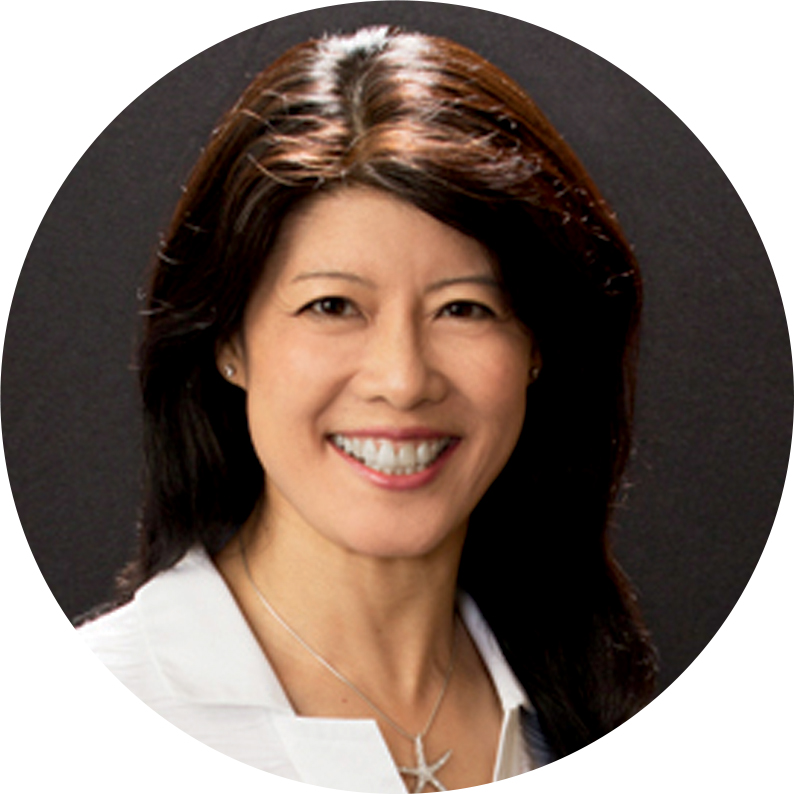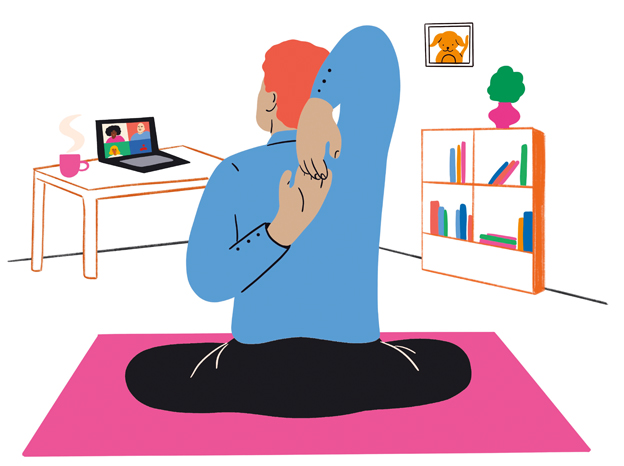
The pandemic years brought significant changes to law firms. Many have been a long time coming and offer a template for a new workplace culture.

Illustrations: Sol Cotti
By Jeannie Naujeck
From where she sits in Midtown Manhattan, Lisa Simpson ’94 T’91 has a comprehensive view of the legal hiring market. A trial lawyer and former member of the management committee at Orrick, she has also served as hiring partner for its New York office and partner in charge of firmwide campus recruiting.
Simpson sees a marked shift in the way attorneys, from new recruits to lateral hires, are thinking about their careers since the start of the COVID-19 pandemic in early 2020. While Simpson — and Orrick — felt this shift was well underway before the pandemic and had already started adjusting for it, the COVID pandemic accelerated the change.
“I think there’s a recognition by both lawyers and our firm that we need to make careers sustainable,” Simpson says. “It takes incredibly hard work to build a top-quality practice — and just like an athlete, lawyers need to recover.
“The folks that I’ve spoken to are looking for flexibility, and a big lesson coming out of the pandemic is that we can be both more flexible and more productive. So if you want to hire those people you need to have that built into your platform.
“We want to get and keep the best people, and if they want more agency in their careers, then we are going to give it to them. We’re willing to embrace that approach because we think overall that’s a better way to build a strong, healthy, and inclusive law firm and our clients recognize it means they get inspired and consistent teams.”

“The folks that I’ve spoken to are looking for flexibility, and a big lesson coming out of the pandemic is that we can be both more flexible and more productive.”
— Lisa Simpson ’94 T’91, a partner in Orrick’s New York office
Three years on, a new model of the law firm workplace is emerging. Nationally, attorneys are strongly in favor of a hybrid model that combines one to three “anchor days” per week in the office with the rest remote. In the American Bar Association’s 2022 Practice Forward survey, 87% of respondents said their employer allows remote work, with 63% able to work remotely either full-time or on their own schedule, and sizable numbers said they would switch jobs for more flexibility.
Associate Dean Bruce Elvin ’93, director of the Career & Professional Development Center, agrees with Simpson, while noting that defining “flexibility” remains an ongoing challenge in the profession.
“Every one of the dozens of employers that I have spoken with recently is genuinely concerned with finding the optimal approach to ensure their new lawyers develop professionally as expected and that their organization continues to achieve its goals, while also recognizing that the landscape of ‘where’ people work is a moving target and that many have different views. It is an ongoing conversation.”
To a large extent, employers are supporting hybrid work, which may not only help with employee retention, but also with reducing fixed expenses. And hybrid work arrangements are just one of several shifts that accelerated during the pandemic years and have now taken root.
Many firms, driven in part by corporate clients, had already implemented metrics-driven diversity, equity, and inclusion programs that are slowly beginning to move the needle on racial, ethnic, and gender disparities in leadership roles — though Elvin notes that diversity at the equity partnership level remains low.
And with support for lawyer well-being widely acknowledged as vital to inclusive culture, compensation packages include an array of wellness benefits that recognize employees’ differing physical and mental health needs, caretaking responsibilities, and cultural backgrounds, and actively seek to counter burnout and improve retention.
Underlying these changes are larger societal trends that had begun to transform the way lawyers and other professionals think of work and what they ask of employers well before 2020. While the COVID-19 lockdowns exposed the fragility of the systems people rely on, from childcare and public schools to support for physical and mental health, generational attitudes toward social justice and work-life balance also have changed. Building a culture that balances teamwork with individual needs is now critical to recruiting and retaining legal talent.
“Early in my career when I was doing recruiting, it was very much like, ‘Just go to the best firm that you get an offer from and don’t really worry about the rest of the stuff. Get trained and then you can go somewhere else if you want to, but go to that firm,’” Simpson says.
“That, I think, is no longer the way that future lawyers are approaching their job searches. There’s a more focused effort at identifying firms that are going to support them in all aspects of their life — not just career, but career, community engagement, pro bono service, and well-being, recognizing that you really need to pay attention to all those facets of yourself in order to succeed.”

Remote work, once a novelty, becomes ubiquitous
Before the pandemic, fully remote work was limited to a small percentage of white-collar employees, and few U.S. employers offered remote or hybrid work options to office-based professionals. But in March 2020, about a third of all U.S. workers began working from home full time. That included more than half of all lawyers, according to the American Bar Association’s 2021 Profile of the Legal Profession.
Law firms that adjusted most easily to remote work when the lockdowns began tended to have a pre-existing institutional culture of flexibility, collaboration, and lawyer autonomy; had invested significantly in cloud-based technology; and already allowed lawyers to work away from the office at least a day a week, Thomson Reuters concluded in its Pandemic Performers report. The most well-resourced firms were able to leverage that platform and emerge as top performers during a period of intense economic activity that created a massive influx of client work, particularly in M&A and capital markets, and pushed revenues and profitability to record highs. Competition for talent quickly intensified, fueling compensation and bonuses at all levels of hiring.
“Certainly in 2021, and in the back half of ’20, a lot of law firms had some of their most profitable, productive years ever,” says Peter Ocko ’97, managing director in the partner practice group at Major, Lindsey & Africa.
“During that time, you saw an avalanche of not only lateral movement, but even in the non-equity partner and associate space. Since there were a lot of health restrictions in place, you might turn in your laptop from one place via UPS and get a new one from the new place [in the same trip].”

“I think you’ve seen a slow march back towards some sort of structure and policy. A lot of firms in the Am Law 200 have been searching for the right nomenclature with regard to what that is.”
— Peter Ocko ’97, managing director in the partner practice group at
Major, Lindsey & Africa, a recruiting firm
Hiring at the 200 highest-grossing firms in 2021 was 56% higher than the previous year, driven by demand for corporate attorneys, according to Firm Prospects. Many were recruited, hired, and trained entirely remotely.
After fits and starts in 2022 with return to office dates that were delayed due to new COVID-19 variants and continuing health concerns, law firms have largely refrained from five day a week mandates — or from enforcing them. Two-thirds of respondents to Withum’s 2022 Law Firm Leadership Survey said their attorneys were working on hybrid schedules, with two or three days per week in office the most common arrangement, and over half said they were making hybrid work policies permanent. Most respondents in Thomson Reuters’ 2022 Law Firm Business Leaders Survey said they would likely support remote work in 2023.
“I think you’ve seen a slow march back towards some sort of structure and policy,” says Ocko. “A lot of firms in the Am Law 200 have been searching for the right nomenclature with regard to what that is.”
A small number of firms, notably Quinn Emanuel, have adopted a fully remote “work from anywhere” policy. More than a year ago, the firm announced that attorneys, including first year associates, would have no obligation to report to an office, except for orientation and onboarding and for client work as necessary. The firm would leverage remote technology for training and mentoring, reconfigure its office space for a “more vibrant” experience when attorneys gather for meetings, team building, and trial preparation, and to maintain its culture, increase offsite gatherings, such as its annual hike in places like the Dolomites in Italy and Laugavegur trail in Iceland.
Indeed, many firms are rethinking their real estate footprint. Some, like Perkins Coie, Davis Wright Tremaine, and Duane Morris report reducing their office space, while others are taking advantage of soft demand for space to expand geographically into new markets and negotiate new deals in prime locations. With fewer people in offices at any one time, a sizeable percentage are considering reducing or reconfiguring their office space with fewer private offices and more “hoteling” desks for in-office days, and adding large casual open spaces to foster socializing and collaboration, Withum found.
Still, with most top-grossing firms expecting some level of in-office attendance, Ocko doubts that permanent remote work will emerge as a dominant trend.
“First, real estate still is a marker of status and stability, whether or not we see a return to the days of the burled walnut corner office,” he says. “You certainly have some virtual firms that are successful. But those firms and maybe the Am Law top 50 think of themselves very differently.
“The other part of it is there are different opinions around integration and onboarding of new lawyers, whether it be partners or associates, how you maintain both an adherence to culture and practice, and also to the ability to learn and interface from one another, which occurs on a very informal level in offices.”
Orrick has long had fully remote attorneys, with each partner class over the past eight years including at least one member who did not live in the market of the office with which they were affiliated, says Simpson. And a third of its members are on some type of flexible work arrangement, such as reduced hours or a compressed workweek.
But the firm’s onboarding and integration processes are now more structured and “high touch” to allow first-year associates to make connections with each other and senior members, and to be able to navigate a hybrid environment with those relationships already established. It’s part of a broader rethinking of the office as a destination for team meetings, trainings, client opportunities, and networking — and less a place for attorneys to commute to every day, sequester themselves in individual offices, and “parallel work,” says Siobhan Handley, Orrick’s chief talent officer.
“We are having success with getting people into the office more often by relying on people thinking of the office more as a hub of connection and community, as opposed to linking it to productivity, which we know we can maintain remotely,” she says.
At Palo Alto, Calif.-based Cooley, attorneys are encouraged to come to the office at least three times a week. Lila Hope ’02, a partner in Cooley’s Life Sciences Partnering practice, says she thrives on personal interactions within the firm’s tight-knit community and finds giving feedback and sharing knowledge in person more effective and rewarding.
“There is flexibility to have a hybrid structure, but people do want to come back in and work together because we really like each other,” says Hope. “The learning experience is different. The community building is different. A whole lot of organic stuff happens and people connect, and all of those are much more attainable when we’re in the office.”
She recalls a recent day at the office revising a document with an associate: “It’s got 200 pages with various parts we were working on at different times and we’re running back and forth, exchanging notes with the pages tabbed. At the end she told me, ‘I learned so much, and it was so much fun working together,’ and that just melted my heart. I was thinking, ‘This is how practicing law should be.’”
Moore & Van Allen, a Charlotte-based firm with about 400 attorneys, is maintaining flexibility on in-office attendance. Attorneys are encouraged to come to the office three times a week but not everyone is choosing to do so. And that’s fine, says Valecia McDowell ’98 T’95, co-head of White Collar, Regulatory Defense and Investigations, head of Civil Rights & Racial Equity Assessments, and a member of the management committee.
“On a team-by-team basis, lawyer by lawyer basis, we’ve given everybody the flexibility to figure out what’s going to work for them,” says McDowell, who like Simpson and Hope is a member of the Law School’s Board of Visitors. “We’re just trying to meet people where they are, which is who we are as a firm. We try to focus on people’s individual needs.”
McDowell is rigorous in managing her team practice and mentoring responsibilities in the new hybrid world. Meetings in her white-collar practice group, which has about three dozen lawyers, are routinely held both on Microsoft Teams and in an office conference room. Members join from wherever they are working that day.
“I feel like I see my people from a regular, let’s-manage-these-matters perspective all the time,” she says. “I do not care where they are most days. It’s just not relevant to me.”
She also keeps a document for everyone she mentors with notes on where and when they prefer to meet and sets regular check-ins.
“I borrowed all of that from how I manage my client development activity. Once we went remote, I thought, ‘These people are as important for me to stay in touch with as my clients. And how am I managing that with my clients?’ And I just tried to mirror that.”
McDowell acknowledges that keeping attorneys connected is more difficult when not everyone is in the office five days a week but maintains that it can be addressed with intentionality. “We’re looking at who’s doing it the best on individual teams, talking to them about tips or advice they can give to other folks on keeping people connected,” she says.
“If you’re trying to create an environment that is as inclusive as possible, you have to listen to people and figure out how to get your clients’ needs met while also respecting the needs of the people who are on your team. And from a diversity perspective, flexibility is an important tool for us in making sure that this is a welcoming place for people, no matter their experience. That’s true for working parents, and we also found that in the wake of the events of the Black Lives Matter movement, sometimes people needed a break — to not always be in the office. That was, I think, a collective learning.”

New DEI frameworks emphasize accountability
The murder of George Floyd in May 2020, subsequent racial justice demonstrations around the country, and a rise in hate crimes against targeted groups brought a new focus on DEI efforts at corporations, many of which issued new diversity guidelines for outside counsel. Seventy percent of respondents to Withum’s 2021 Law Firm Leadership Survey said their focus on DEI initiatives increased in 2020, although that dipped to 62% last year.
Orrick launched a Racial Justice Fellowship Program that pays five experienced attorneys their full salary to spend a year embedded with organizations like Common Future and Lawyers’ Committee for Civil Rights Under Law. In 2021 it partnered with Legal Innovators to introduce a fellowship program that aims to increase the pipeline of junior associates from underrepresented backgrounds, such as law schools typically overlooked by Big Law recruiters, and provide those lawyers with the training they need to succeed. The program has been so successful that the firm has engaged Legal Innovators to deliver a version of the training to all incoming junior associates.
Under a DEI action plan approved in August 2020, Cooley pledged to strengthen existing efforts within the firm and to direct more resources toward early engagement and recruitment programs such as its long-running summer 1L Diversity Fellowships.
“It’s really about doing what’s best for individuals, trying to help them become the best person and lawyer they can be, and giving people a path and opportunities at Cooley,” says Hope.

“It’s … about identifying folks who would be a good fit here. And not only do we recruit them and hire them, but we want to make sure there is an opportunity for long-term success, and we’re committed to helping them achieve it.”
— Lila Hope ’02, a partner at Cooley, in Palo Alto
“It’s more about identifying folks who would be a good fit here. And not only do we recruit them and hire them, but we want to make sure there is an opportunity for long-term success, and we’re committed to helping them achieve it.”
Moore & Van Allen took immediate steps to extend its outreach to diverse employees, expanding its affinity groups from one group for lawyers of color to separate groups for Black, Hispanic, Asian Pacific, and LGBTQ+ lawyers.
“All of that really came from the emotional necessity for folks to have a place to feel safe and comfortable,” says McDowell, who co-chairs the firm’s diversity committee. “The issues that were coming up for our Black lawyers were so specific to our experiences as Black people that it wasn’t always comfortable to talk about it in the larger space.”
The firm increased outreach to law students from diverse backgrounds and launched new community programs, partnering with other local law firms to provide volunteer legal services to low-income entrepreneurs and small businesses. Associates, counsel, and staff attorneys can now receive up to 50 hours of billable credit annually for diversity and inclusion work, and many other national firms, including Orrick and Cooley, have adopted similar policies.
Additionally, Moore & Van Allen hired a consultant to do a cultural assessment of its own operations, similar to the civil rights audits McDowell conducts for corporate clients. The exercise identified nine areas to address within the firm, including culture and shared values, onboarding and embeddedness, inclusion and belonging, work allocation, and pathways for advancement. Members from all levels of the firm joined workstreams charged with proposing ways to make each process more equitable. Those recommendations are starting to be rolled out.

“If you’re trying to create an environment that is as inclusive as possible, you have to listen to people and figure out how to get your clients’ needs met while also respecting the needs of the people who are on your team.”
— Valecia McDowell ’98 T’95, a partner, practice group head, and member of the management committee at Moore & Van Allen in Charlotte
“I have an acute awareness of the importance of that work and the impact it can have, whether it’s a public audit like we see in the shareholder space, or a private privilege review,” says McDowell. “So we, as an institution, decided that we wanted to do likewise.”
Law firms have long struggled to diversify, especially at the top levels. While people of color grew to a record 28.3% of all associates in 2021, they made up only 11.4% of partners in major U.S. law firms, with Black partners comprising only 2.3% of all partners, according to the National Association for Law Placement (NALP) 2022 Report on Diversity released in January. Nearly half of all associates were women, but just over a quarter were partners.
However, The American Lawyer’s 2022 Diversity Scorecard showed the largest gains in the number of minority attorneys in 20 years, with the “war for talent” creating hiring opportunities for attorneys from more diverse backgrounds.
Both as a strategic business priority and with pressure from corporate clients, the legal profession had begun to employ data-driven approaches to diversity, equity, and inclusion prior to 2020. Those include the Diversity Lab’s Mansfield Rule, a certification program for diversifying leadership in the legal profession and improving transparency of pathways to advancement. Participating firms commit to considering women lawyers, racially and ethnically diverse lawyers, lawyers with disabilities, and LGBTQ+ lawyers as at least 30% of the candidate pool for leadership positions and activities that develop leaders.
The 41 law firms in the Mansfield Rule pilot saw racial and ethnic diversity on their management committees increase by 4.4 percentage points, a rate 30 times higher than firms not in the program. Diversity Lab, an incubator focused on strategies to boost diversity and inclusion in law, cites external accountability and knowledge sharing among participants as key to the program’s success. Nearly 400 legal workplaces, including more than 180 large law firms and 140 midsize firms, have joined since the 2017 launch.
Ocko, the recruiter, says large firms would do well to look outside traditional metrics that exclude good candidates to find lawyers the firm can develop and grow. They should also examine, and break, any biases they may hold about what kinds of people will be successful in their organizations.
“There are a lot of tremendous, high-quality lawyers out there who I think sometimes get overlooked,” he says. “Where the rubber meets the road is when firms are able to look at someone who they believe makes sense, and would be, whether in the near term or long term, a valuable addition to the firm — not only because they’re diverse, but because of their practice and perspective and direction — and bring that person on as opposed to spending money on a lot of other things.”
He calls diversification at law firms a matter of fund allocation: “Major law firms have to decide that it’s worth investing in and making those hires — not just at the associate and the partner levels but making investments in communities to develop and widen the pipeline. That, to me, is the real investment in diversity.”

Creating a culture of wellness and mental health
For many lawyers, the stresses of the pandemic years were compounded by overwork and burnout as firms dealt with a large volume of business. The pandemic exposed cracks in the façades of lawyers who like to appear in control, says Hope, who sits on Cooley’s mental health and wellness committee and is chairing a BOV task force on lawyer wellness.
“You look at people and think, ‘They’ve got everything together,’ but they don’t,” she says. “Nobody does. We all are kind of treading water at some level, and I think the pandemic may have done us a favor in showing, ‘Hey, we’re all vulnerable here.’”
Now, mental health is a front-burner issue, with firms elevating it to the executive suite. Kirkland & Ellis hired a director of wellbeing in 2019. At Weil, a litigation partner made a career transition to become its chief wellness officer. Twelve Big Law firms sponsor the Institute for Well-Being in Law, launched in 2021 to promote a culture shift in the profession that prioritizes mental health.
Workplace assistance programs have become more robust, accessible, and tailored to employees’ particular needs. Benefits now include such amenities as billable hour allotments for wellness activities and bonus money to spend on a massage, dinner out, or a weekend getaway. Orrick offers attorneys a week of “unplug” time each year where they are expected to completely disconnect from phones, email, and videoconferences.
Lawyer well-being is a critical part of engagement and retention. Hiring and onboarding is a costly part of doing business, and associate turnover in the Am Law 100 was higher than usual in 2021 due to intense competition and pay. Yet lawyer surveys show that a supportive culture goes further to create firm loyalty than raising compensation.
“I think there’s a lot more focus on wellness than there ever was when I was starting out,” Simpson says. “If you took care of yourself, great, but no one really talked about it.
“The recruits of today are really looking at those issues and putting a level of importance on them. Are they going to choose a firm for wellness over another firm? Maybe not for their first job, but some are, and in the lateral market we certainly see it.”
Lawyers also desire clarity regarding advancement pathways, support to do so, and viable career alternatives to the partner track, such as less intense “career associate” positions that may handle functions such as research, drafting, and due diligence. Training and mentoring were top features that respondents, especially younger attorneys, wanted to see more highly valued by their firms, followed by more attention to diversity and policies to support well-being and work-life balance, according to Major, Lindsey & Africa’s 2022 Law Firm Culture Survey.

“Some [firms] that had not previously done so are trying 360 degree reviews of recent partners to help them be better managers, while others are adding internal coaches who can help people at all levels develop in different ways.”
— Bruce Elvin ’93, associate dean and director of the Career & Professional Development Center
Firms are also increasing their focus on developing critical management and development skills with a goal of adjusting to hybrid work and general improvement of the work environment, says Elvin, who teaches a seminar on the business and economics of law firms.
“Some that had not previously done so are trying 360 degree reviews of recent partners to help them be better managers, while others are adding internal coaches who can help people at all levels develop in different ways,” he says. “While some firms have employed these tools for a number of years, a growing number of law firms are focused on those types of efforts.”
As a consensus emerges on the future workplace, development will almost certainly include training on how to collaborate and communicate in a hybrid world. While in the long term fully remote work might be reserved for experienced lawyers with proven competencies and practices where distributed teams are already common, many law firms appear to be permanently evolving toward a model that offers team members more flexibility, choice, and autonomy on days working out of office and a complement of services for developing, maintaining, and supporting a diverse pool of talent.
In the meantime, the office isn’t going away. Rather, it is becoming a locus for interactions with colleagues, including collaborative work training, team building, and social interactions that help maintain organizational culture and cohesiveness and ensure early-career lawyers have the resources and mentoring they need to develop.
If a recession brings mass layoffs in the legal industry, the dynamic may change. But maintaining the right balance of flexibility to meet the needs of the workforce and the needs of firms appears to be the future of the profession.

See Also: Seven Pandemic Pivots »
